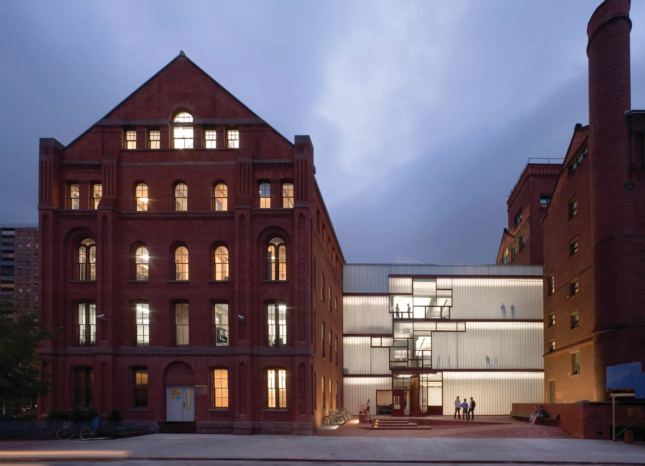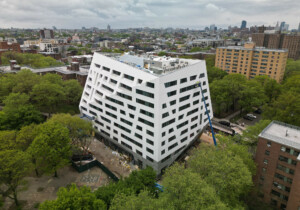Pratt Institute began in 1887 in Brooklyn’s Clinton Hill neighborhood as an affordable college accessible to the working class of New York. Founded by industrialist Charles Pratt, whose company, Astral Oil Works, was absorbed into John D. Rockefeller’s Standard Oil Trust in 1874, it was run as a charity for many years. It still had a Pratt family member, Richardson Pratt Jr., as president in 1990, the fifth family member to serve in that position. Its ninth president, Henry Saltzman, who served from 1970 to 1972, was an urban studies specialist, but other non–Pratt family leaders came from the fields of education and academia. Now for the first time, the school has selected a president, Frances Bronet, who has degrees in architecture and civil (structural) engineering. This, in itself, is a unique background for someone leading a design institute, but of course, she was also selected for her accomplishments in and out of design academia. In this interview, we questioned Bronet about her design background, what it brings to the school, and how it informs what she hopes to accomplish as the institute’s 12th president.
William Menking: You’ve had a distinguished 20-year career as an educator before becoming Pratt Institute’s 12th president. You have degrees in architecture and civil engineering, and a diploma in management. This is not a common degree path to becoming a college president. How did it happen that you went from being a designer to a president?
Frances Bronet: I have always imagined what it would be like to be the head of a think tank, from the time I was 17. I may not have known exactly what that meant, but at this moment we can all agree that leading a college would qualify. In Montreal, I worked in prominent, faculty-led architectural offices, and ultimately in a partnership with two colleagues.
After graduating from McGill, I began teaching at McGill, Vanier, and Montreal Technical College in the evenings after working in practice during the day. It didn’t take me long to realize that I wanted to continue in the academy, and I came to New York City to study at Columbia University for grad school. As an engineer and an architect with solid experience as a teacher, I was offered a few jobs, from the University of Texas to Rensselaer Polytechnic Institute (RPI), as a tenure-related faculty member. It’s hard to believe when looking back, but I taught for almost 30 years. In my experience, the academy, somewhat like an ambitious office, offers an amazing amount of freedom. As a faculty member, you have an incredible bandwidth for experimentation, new ideas, and collaboration. In many ways, it is both an entrepreneurial environment and one that has manageable boundaries.
As soon as I was tenured, I became associate dean (I was also a new parent!). This was a great experience. I love building relationships and brokering genius—and being in an administrative position lets me do that. There are certainly many architects who would avoid administration, but it can be unbelievably creative. And where else do you get to engage this extraordinary amount of intelligence and aspiration?
I then left RPI to become dean of the School of Architecture and Allied Arts (now the College of Design) at the University of Oregon. Being dean across domains—from painting to architecture to public policy—gave me access to understanding the big picture. When an even larger university-wide landscape was made available to me as acting provost at Oregon, I couldn’t resist. The ability to take opportunities across disciplines and connect remarkable people, projects, and places was key, as was designing teams where the unexpected can unfold.
From there, I went on to be provost at Illinois Institute of Technology (IIT) in Chicago and now have the honor of being the president of Pratt Institute. The school has a massive external face, leading through design—and as an extreme extrovert, this position is perfect.

WM: The next logical question is how did an architecture and engineering degree prepare you for your academic career? Did it give you particular and unique insights into design education?
FB: Absolutely. Studying and working in these environments exposed me to various ways of thinking and unique modes of defining complex problems and solving them. I was impressed by how distinct expertise came together to make it all work. We all have different modes of learning and teaching, and people self-select these disciplines. For me, architecture, although tough, resonated with how I experienced and performed in the world; engineering put me in a place that was unfamiliar, so that very precariousness opened up a new universe.
WM: Your resume highlights your publishing career “on multidisciplinary design curricula connecting architecture, engineering, STS (science, technology, and society), dance, and fine electronic art.” You’re now the president of an art and design institution of higher education. How will you expand or develop interdisciplinarity between schools at Pratt?
FB: Ah! That would be the provost’s gig.
And now that we have a strategic plan developed with all our constituencies, this very recommendation is central. I could guide, advise, and listen, but the provost is the chief academic officer. My work is how what is going on in the world impacts our strategic vision and how we share this beyond our own gates, building broad constituencies of support. We have 1,200 faculty members—many of whom have their own practices—already connected to the world at large and bringing the world here when they teach. How can these connections be magnified and supported? Many educational enterprises are building experiential, embodied, problem-based, and practice-oriented courses. Pratt has been doing this for more than 130 years. That is where we should take a leadership role.
WM: What are the challenges of directing an art and architecture and design academy in 2019? How do you hope to change or expand the institute?
FB: Some challenges transcend the institute—preparing students for careers that don’t yet exist, accessibility, including cost, and wellness, to name a few. But for us, it is that excellence will be measured by how a private institution works for the public good, from social and environmental to cultural metrics. We are part of the economic and social engine that has transformed our neighborhood into a new, creative economy. And we must do more to create an academic institution that can collaborate to make a more equitable, inclusive, and sustainable community.
WM: What are the challenges and advantages of directing an institution of higher education for creative thinkers and makers in New York City?
FB: The world’s best and brightest are here or are coming to New York City. It is also important to be aware that some great talent is outside of New York City, too. When thinking about the great diversity of this city, we ask ourselves, how do we represent the communities in which we sit? How do we collaborate with all this extraordinary talent and get out of institutional silos? How can we leverage our practice-based faculty, who bring both new ideas to their students and their students’ ideas to bear on their practices?
There is an incredible opportunity to ask what are the key projects, and how do we partner and get involved? How are we part of a larger ecosystem?
Climate change, rapid urbanization, ethical practice, and so forth impacting our world will require research, working across many disciplines, universities, and other organizations. This infrastructure can serve as a frame for true participatory democratic practice. Pratt is uniquely poised to do this type of engaged work and be part of this ecosystem. Our goal is to equip our students as cultural, environmental, urban, design, and education contributors and leaders. We are sitting next to one of the great new emerging developments at the Brooklyn Navy Yard. That’s where you’ll find our Consortium for Research and Robotics. It’s clear to me now that I was on the right track envisioning myself at a think tank. But in today’s world—with so much possible through technology and collaboration—we work in think-make tanks.
There is so much possibility for partnership that, indeed, it will be the only way to address some of the most difficult issues confronting us. Designers are optimists. As Nobel laureate Herbert A. Simon said, “Everyone designs who devises courses of action aimed at changing existing situations into preferred ones.”











